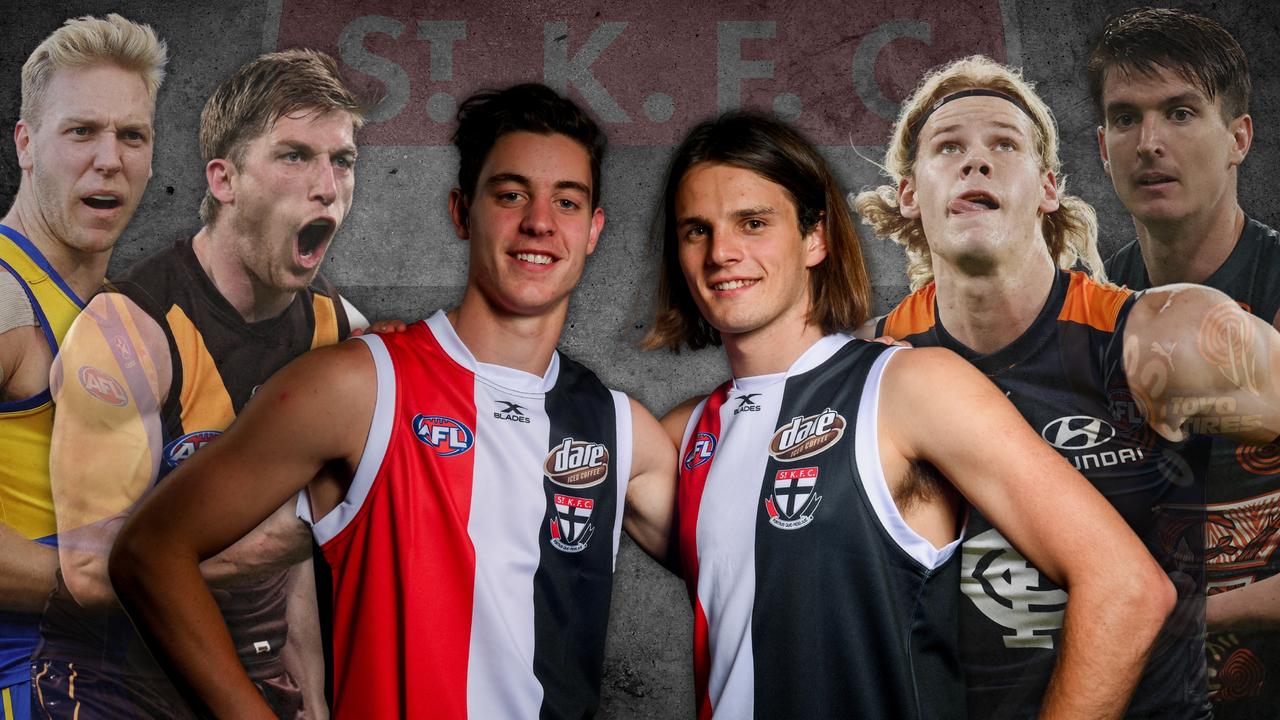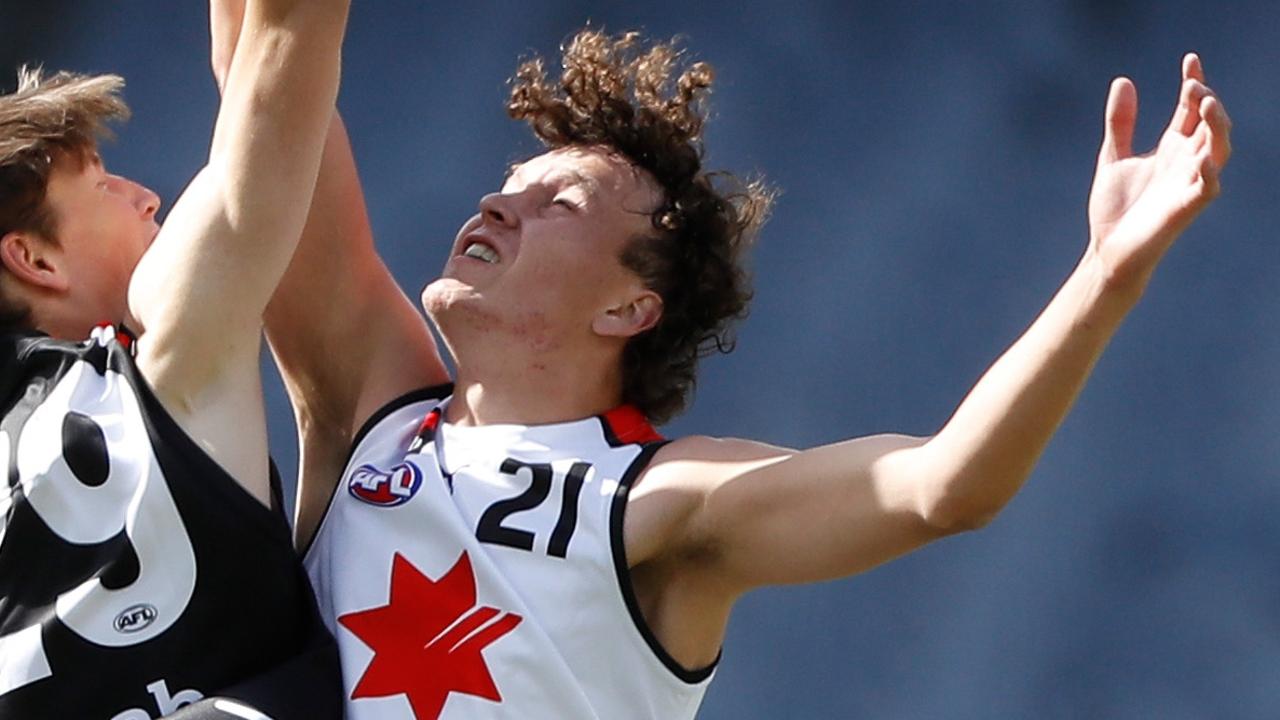Where the AFL’s 2023 Collingwood-Brisbane epic ranks on the definitive list of greatest grand finals
What determines the greatness of a grand final and where does the AFL’s latest edition rate? SHANNON GILL applies his definitive system to separate the best of the best.
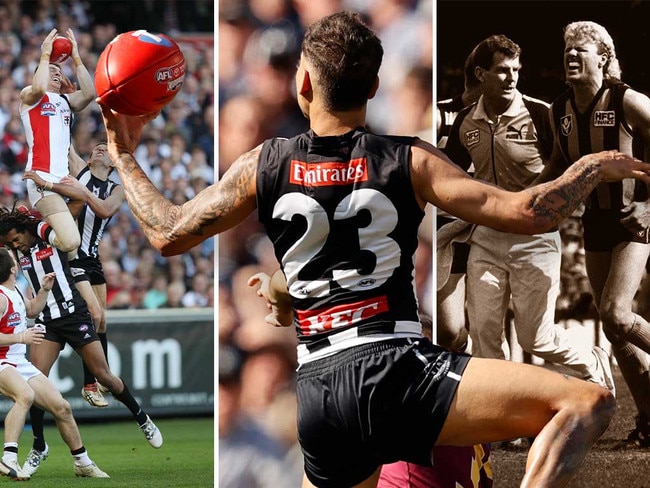
AFL
Don't miss out on the headlines from AFL. Followed categories will be added to My News.
We are already awash in talk about trades that might happen, trades that might have happened but are now definitely not happening, and trades that should happen but never will.
Throw in free agent signings, best and fairest results and draft pick swapping, and you could almost wipe your memory of the grand final if you’re not of the black and white persuasion.
Which is a real shame.
This was one of the great grand finals. The first half specifically has claims for the best half of footy you could ever hope for.
We need to luxuriate in this for a little while as it doesn’t happen every year. Of all the great memories of footy in the 1990s, the closest grand final of that decade was 28 points.
So instead of looking to 2024, let’s stop for a moment and consider: just how good was the 2023 grand final?
READ MORE ON CODE SPORTS
SAM MITCHELL: WHAT TEAMMATES REALLY THOUGHT OF HIM
INSIDE THE HEARTBREAKING END OF A COLLINGWOOD AFL DREAM
HOW HIGH-FLYING CHAD WARNER STAYS GROUNDED
THE TWO 'BEST MATES' INTEGRAL TO SWANS FLAG DREAM
STEVIE J: THE CUTTING SPRAY THAT SPARKED CATS DYNASTY
'F*** EVERYONE ELSE': SECRETS OF GEELONG'S NEVER-ENDING RUN
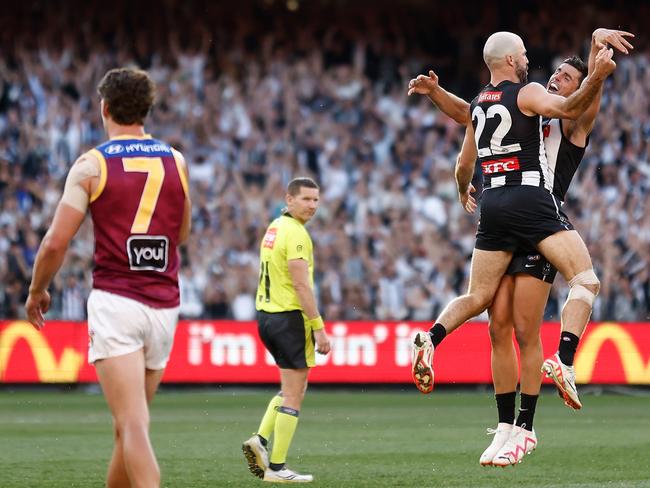
The easy way to decide is to make a quick comparison with another great grand final of years past and decide whether the gut says better or worse.
But to do this properly you need some science added to the obvious subjectivity that comes when choosing a list of favourites from VFL/AFL history.
To assess where 2023 ranks in the annals, here is a set of criteria to decide the most memorable grand final of all time, taking into account the things that make games great in the moment and to watch again as a neutral fan.
1. Game Style (GS): Beauty of the game is in the eye of the beholder, but this criteria is judged on the attractiveness of play: skills, free-flowing play, scoring and, in some cases, sheer brutality of the contest. Some games are marked down simply because of wet conditions that made it significantly harder to showcase the best of the game.
2. Closeness (CLOSE): The competitiveness of the contest throughout the four quarters, how long the result appeared in the balance.
3. Historical Importance (HI): This rating attempts to capture the significance of the match on broader football history. Did it change the game in any way, does it help define an era or a club’s history, or was it the genesis of rivalry.
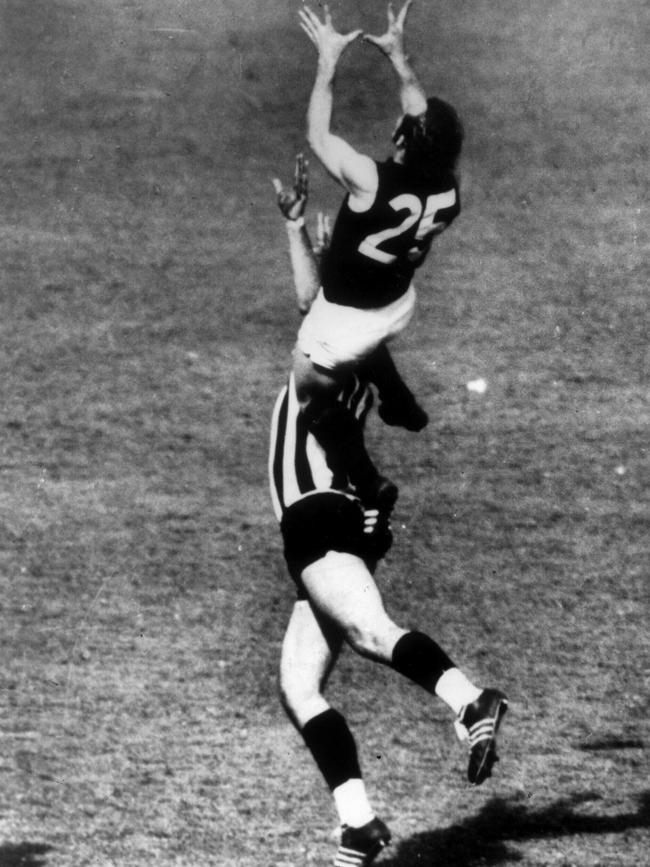
4. Star Power (SP): How the game displayed the star players of the time. Whether it includes a group of players historically comparable with greats of other eras, and did they demonstrate their best on the day.
5. Iconic Moments (ICON): Highlights that the grand final provided. The small moments of play – whether great marks, goals or clashes – that are endlessly rewatchable and instantly recalled. The type of moments that inspire commentary mimicry, and maybe even clumsily attempted physical mimicry from schoolyards to backyard BBQs.
6. Finish (FIN): Whether the grand final kept fans in suspense until the end. Did the final quarter, or sometimes the final minutes, keep us all on the edges of our seats?
For each grand final, each category is ranked out of ten when compared to the average VFL/AFL game. Scores across all six criteria are tallied, with the highest number showing what is truly the most memorable grand final ever.
The grand final ratings start from 1966, which is the oldest ‘great’ grand final that survives in a readily available form, consistent with the typical match broadcast we’ve had over ensuing years.
Of course the ratings are subjective so the debate is endless, but before you disagree angrily with why your team’s premiership win is not ranked higher, take a moment to work through the exercise of why a game is great.
And a spoiler alert: what we just witnessed in 2023 is comparable with the very best.
20-10
20) 1979, 1992, 1997, 2008
Total Score: 45
18) 1971, 1981
Total Score: 45.5
15) 2001, 2002, 2011
Total Score: 46
14) 2016
Total Score 46.5
13) 1984
Total Score: 47.5
10) 2005, 2006, 2009
Total Score: 48
9) 2018: West Coast 11.13.79 def Collingwood 11.8.74
Total Score: 49 (GS 6.5 CLOSE 9.5 HI 7 SP 7 ICON 9.5 FIN 9.5)

Eagle Dom Sheed’s boundary thread may go down in history as the most iconic goal to win a grand final. Its sheer degree of difficulty, combined with the time left on the clock (1:45) and the precision and audacity of its build up is hard to argue against.
Its drawback is that the game itself was not beautiful in an aesthetic sense (pre-stand rule when congestion was ruling the league) and the teams would fail to appear in grand finals in the next few years.
But to be the only grand final in VFL/AFL history where the teams turned at three-quarter time level and then contain the most spectacular of goals to finish it enshrines it among history’s best.
8) 2012: Sydney 14.7.91 def Hawthorn 11.15.81
Total Score: 49.5 (GS 8 CLOSE 8 HI 8 SP 8.5 ICON 9 FIN 8)

The seesawing classic where a brave Sydney upset a Hawthorn team destined for a dynasty. The only drawback could be the fact that there were momentum swings in the first half that saw each dominate quarters of action while the other was ineffectual, but the second half had it all.
The icons starred. Lance Franklin played his best grand final to haul the Hawks back into the game, while Adam Goodes, on one leg, created forward opportunities all day before kicking an iconic goal himself. It all set up a tense final five minutes, with the result decided by Nick Malceski’s last-minute snap.
Its historical significance has grown over the past decade. The Hawks would complete a three-peat off the back of the loss, one against a Swans team now containing Franklin. The first enthralling title fight of heavyweights.
7) 1977: Collingwood 10.16.76 drew with North Melbourne 9.22.76
Total Score: 50 (GS 7 CLOSE 7 HI 9.5 SP 7 ICON 9.5 FIN 10)
The first live television broadcast of a grand final into Melbourne, including the first pre-game entertainment, was the birth of the modern grand final as a cultural monolith.

The game itself was a scrappy affair with the bizarre situation of North Melbourne not kicking a goal for a half a game, before storming back from 27 points down at three-quarter time as the Pies stopped to a walk.
This was the technicolour sequel to Ron Barassi’s 1970 coaching masterclass. The flamboyant suit and the release of John Powers’ book The Coach, where he was embedded with Barassi and the Roos for the season, just added to the legend.
In the end it had a startling grandstand finish where the match was drawn due to Pie Ross ‘Twiggy’ Dunne’s iconic pack mark and flat punt goal. The replay next week was a much more free-flowing affair, yet for historical matters the 1977 original will always be a landmark.
6) 1967: Richmond 16.18.114 def Geelong 15.15.105
Total Score: 51 (GS 9 CLOSE 9 HI 8 SP 9 ICON 8 FIN 8)
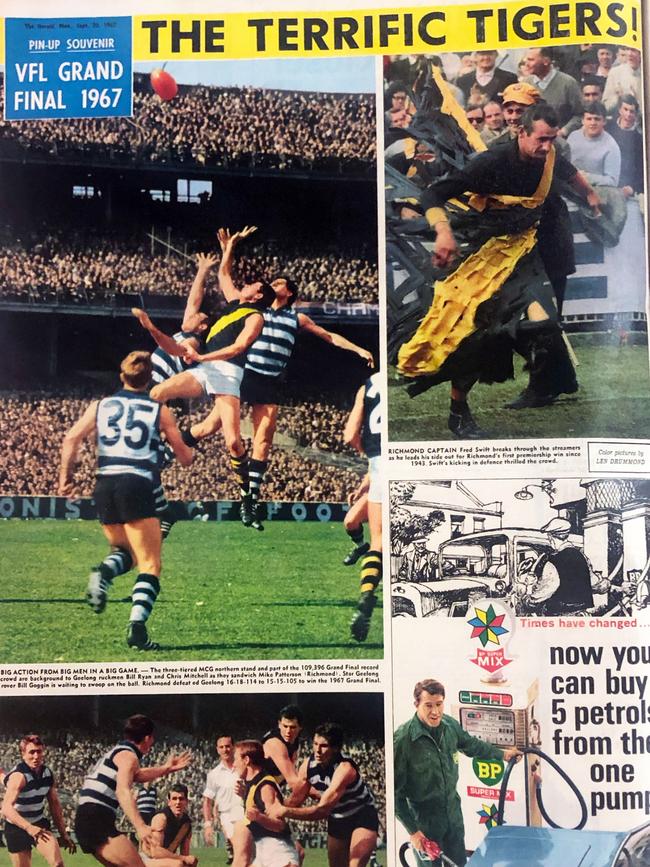
Richmond Football Club’s Tony Greenberg wrote a passionate column a few years back on how the 1967 contest is the most underrated grand final in memory, and he’s right.
As a pure game of football this is about as good as it gets.
Fast, high scoring and packed, it would awaken an era of power for Richmond and get the tailend of a brilliant Geelong team. In Polly Farmer, Kevin Bartlett and Royce Hart the match contains three Australian Football Hall of Fame legends, and all three played pivotal roles. There’s a clutch of other Hall of Famers all displaying their very best.
Hart’s iconic mark in the middle of the MCG and Bartlett’s goal to seal the game, when they were aged 19 and 20 respectively, heralded in the 1970s three years early.
5) 2010: St Kilda 10.8.68 drew with Collingwood 9.14.68
Total Score: 51.5 (GS 7.5 CLOSE 8 HI 8 SP 9 ICON 9 FIN 10)
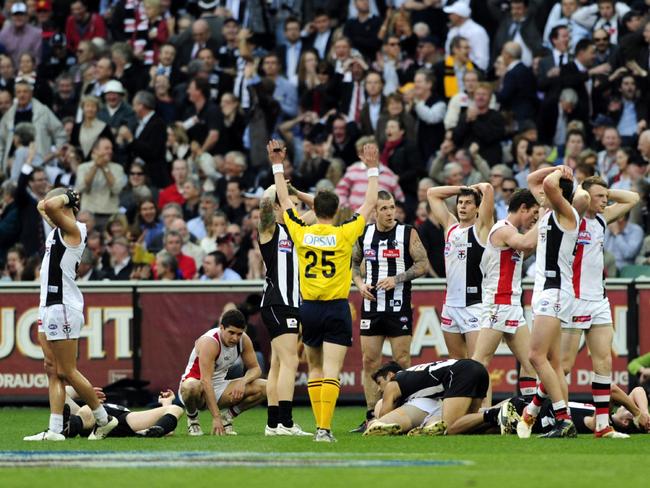
There were eerie similarities to other great grand finals past in this one, from the wicked bounce of a ball in the city end pocket (1966), to Collingwood being headed after a big lead before equalising for the draw (1977).
The St Kilda and Collingwood face-off did not live up to great heights in the first half, with the Saints battling to stay in the game. But the second half lifted remarkably. The St Kilda comeback led to a pulsating last quarter and final five minutes where the lead swapped and ultimately stayed locked.
Both teams were stacked with stars and the craziness of the finish would eventually force the end of the grand final draw. If Brendon Goddard’s huge pack mark and goal had put St Kilda in front for good, we may now talk about it as the greatest individual highlight in grand final history.
The anticlimactic replay, and the associated chaos of putting on another grand final in modern times, perhaps took the shine off the draw, but it’s deserving of its spot as a classic.
4) 2023: Collingwood 12.18.90 def Brisbane 13.8.86
Total Score: 52 (GS 9 CLOSE 10 HI 8 SP 8 ICON 8 FIN 9)
Recency bias? Perhaps. Yet the match was packed with all the elements that make grand finals great. Let’s examine why in more detail.
Game Style (9): The first half was frenetic and about as good as footy can possibly be in a professional and coaching-influenced era. The most goals kicked in the first half of a grand final since 1989 is a good indication of how the game was flowing.
Closeness (10): The biggest margin all day was 13 points, there were ten lead changes and the scores drew level four times. This really was the definition of a heads bobbing finish to a horse race, Collingwood just happened to be in front when the siren sounded.

Historical Importance (8): This is the category that could move most over time. At the moment it would appear the importance will at least hold its status, specifically the first half and its exhibition of skills. What happens to Collingwood and Brisbane next dictates how history views the two teams.
Star Power (8): Similarly the stars of these teams and their career arc could move the dial on this metric. There would appear to be at least three stone cold certainties for the Hall of Fame (Scott Pendlebury, Lachie Neale, Steele Sidebottom), a player whose career would need to end prematurely to not get in (Nick Daicos), another two that would only have to play out their careers solidly to get there (Darcy Moore, Harris Andrews), then a bunch of others you wouldn’t rule out if their careers continue to flourish.
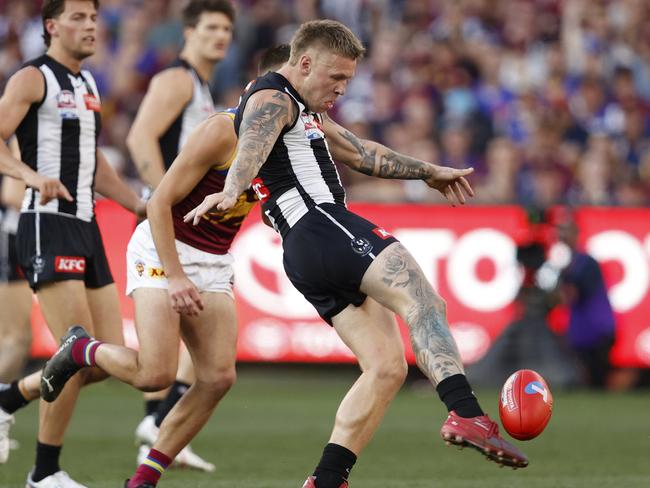
Iconic Moments (8): Already there are moments burned in football fan memories. The Jordan De Goey goal, the Sidebottom goal, the Bobby Hill mark, the Zac Bailey goal to name a few. The quality of play means you’ll soon rediscover more gold when you rewatch.
Finish (9): The mania of the game may have been doused a little in the second half, but it ratcheted up with the lead changes in the final six minutes and stayed alive up until the bell with the what-if moment of the bad Neale/Bailey advantage call.
Time will tell, but 2023 sits comfortably in this position for the moment. It may even scale greater heights with hindsight.
3) 1966: St Kilda 10.14.74 def Collingwood 10.13.73
Total Score: 52.5 (GS 7 CLOSE 9 HI 10 SP 7.5 ICON 9 FIN 10)
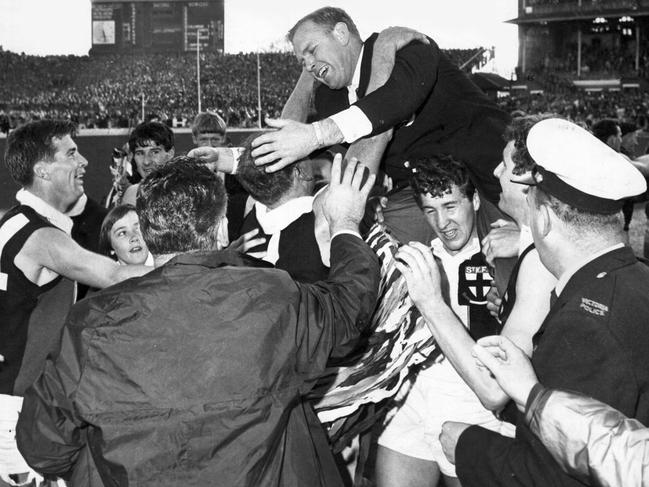
There is so much wrapped up in the mythology, romance and tragicomedy of St Kilda that is defined by this game.
One premiership. One point.
And that’s without looking at the Collingwood side of things, where the Colliwobbles became the start of a 25-year trend.
St Kilda’s one and only premiership is the reminder that underdogs can win and fairytales can come true. That it is the club’s only premiership in 150 years of operation gives it outsized historical weight, but then the game was a classic too.
It might not be as free flowing as others, but it was close all day until a wobbly Barry Breen kick dribbled through and broke the deadlock in the dying minutes.
The legendary television call of the game has formed part of the footy lexicon for decades since. Aside from the iconic moments on the field, it marked the moment where television and football became forever intertwined.
2) 1989: Hawthorn 21.18.144 def Geelong 21.12.138
Total Score: 53 (GS 10 CLOSE 7 HI 9 SP 9.5 ICON 9.5 FIN 8)
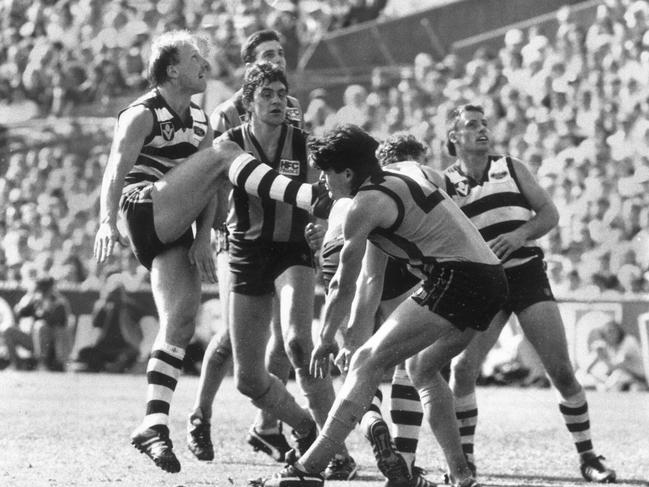
There is a school of thought that the 1989 grand final has become a little overrated. How can a game that for large portions had a six-goal separation between the teams be a classic?
It is obviously the one element that marks this game down, but for it to saddle the game as a whole would be totally misreading the way it was played. It was six goals on the board but Geelong threatened to close the gap all day. Then they did in a hurry – 1989 was the high point of hard running, hard hitting, offensive footy before coaching sophistication would gradually curtail it. It had stars everywhere.
Nine Hall of Famers played (with a few likely to be named legends in years to come) and the two biggest stars of the day, Dermott Brereton and Gary Ablett, had signature moments.
A swag of Ablett’s nine goals qualify as iconic, while the brutal football assassination of noted football assassin Brereton at the opening bounce may be the most dissected co-ordinated hit since the one from the Dallas book depository. Except Dermie got up and kicked goals.
With players dropping everywhere and Geelong still surging, an extra few minutes would surely have seen, at the very least, a draw. Two gunslinging teams emerged with 21 goals each and just six points apart.
It was wild and it encapsulated an entire era like no other game has ever done.
1) 1970: Carlton 17.9.111 def Collingwood 14.17.101
Total Score: 53.5 (GS 8 CLOSE 8 HI 10 SP 9.5 ICON 10 FIN 8)
Some 53 years on, the 1970 grand final remains the benchmark.
Just as 1989 summarised an era, 1970 helped spawn everything that came afterwards. It scores perfect marks for historical importance and iconic moments because there are so many.
People will shout commentator Mike Williamson’s catchcry to describe perhaps the greatest grand final mark of ‘Jesaulenko you beauty’ for however long the game is played.
They’ll speculate about what Barassi said to his Carlton players at halftime that could bring them back from a 44-point deficit and define the cult of coach and football’s greatest name.
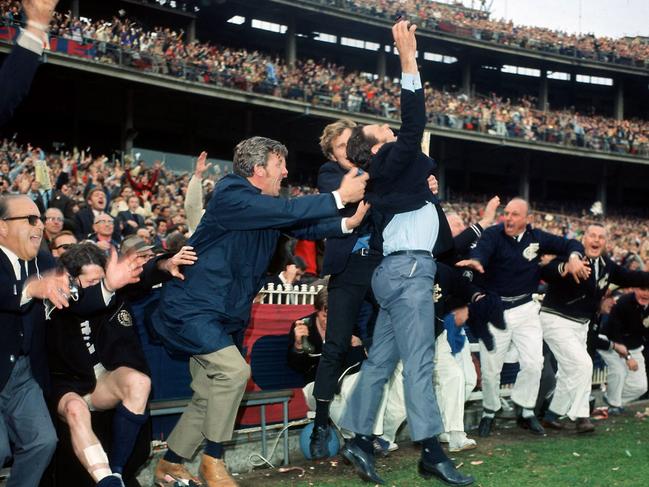
They’ll see a Carlton team forcing itself to play the game differently to what they’d ever done before. Playing on at all costs and, shock horror, handballing as an attacking weapon to create momentum that would lay the path for the future of the game.
They’ll be confused about how a little known Ted Hopkins came on, kicked four goals, turned the game on its head and barely played again.
They’ll talk of the pop idol of a city, Peter McKenna, kicking a bag of goals for the losing team.
They’ll be enchanted by the enigma of Brent Crosswell, who many say was the best man on the ground.
They’ll wonder how Jezza’s tumbling kick from the centre of the ground kept bouncing all the way through the goals and finally put the result beyond doubt in the dying minutes.
Every time Collingwood play Carlton they’ll pinpoint this day as the most famous day in the game’s most famous rivalry.
But they still won’t be able to comprehend how more than 121,000 people packed into the MCG to watch it.
The biggest grand final and the best.
Originally published as Where the AFL’s 2023 Collingwood-Brisbane epic ranks on the definitive list of greatest grand finals



